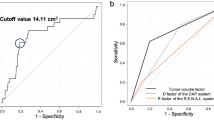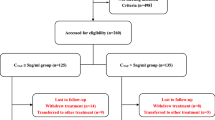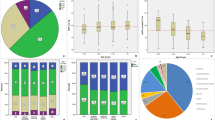Abstract
The aim of this multicentre study was to document the nephrotoxicity associated with ifosfamide and evaluate risk factors in 148 children and young people with sarcomas who underwent investigation of renal function on one occasion each, at a median of 6 (range 1–47) months after completion of ifosfamide (median dose 62.0 (range 6.1–165.0) g/m2). Investigations included glomerular filtration rate (GFR), serum bicarbonate (HCO3) and phosphate (PO4), and renal tubular threshold for phosphate (Tmp/GFR). A clinically relevant ‘nephrotoxicity score’ was derived. GFR was < 90 ml/min/1.73 m2in 61 of 123 evaluable patients, Tmp/GFR < 0.9–1.1 mmol/l (age-dependent) in 45/103, serum PO4< 0.9–1.mmol/l (age-dependent) in 28/135, and serum HCO3< 20 (< 18 in infants) mmol/l in 22/95. Of 76 fully evaluable patients: 50% had mild, 20% moderate and 8% severe nephrotoxicity. Higher total ifosfamide dose correlated significantly with greater glomerular and tubular toxicity (P< 0.01); other risk factors, including age at treatment, demonstrated no consistent significant independent effect. Chronic ifosfamide-related glomerular and proximal tubular toxicity were common in this large comprehensive study. Restriction of total ifosfamide dose to < 84 g/m2will reduce the frequency of, but not abolish, clinically significant nephrotoxicity, whilst doses > 119 g/m2are associated with a very high risk of severe toxicity. © 2000 Cancer Research Campaign
Similar content being viewed by others
Article PDF
Change history
16 November 2011
This paper was modified 12 months after initial publication to switch to Creative Commons licence terms, as noted at publication
References
Arndt C, Morgenstern B, Wilson D, Liedtke R and Miser J (1994) Renal function in children and adolescents following 72 g/m2of ifosfamide. Cancer Chemother Pharmacol 34: 431–433
Ashraf MS, Brady J, Breatnach F, Deasy PF and O'Meara A (1994) Ifosfamide nephrotoxicity in paediatric cancer patients. Eur J Paediatr 153: 90–94
Ashraf MS, Skinner R, English MW, Craft AW and Pearson ADJ (1997) Late reversibility of chronic ifosfamide-associated nephrotoxicity in a child. Med Pediatr Oncol 28: 62–64
Barratt TM (1974) Assessment of renal function in children. In: Modern Trends in Paediatrics 4. Apley J (ed), 181–215. Butterworth: London
Barratt TM, McLaine PN and Soothill JF (1970) Albumin excretion as a measure of glomerular dysfunction in children. Arch Dis Child 45: 496–501
Biron P, Philip T, Pinkerton R, Provensal C and Brunat-Mentigny M (1987) A regimen with ifosfamide and cis-platinum in osteosarcomas: a phase-II study. Contrib Oncol 26: 125–130
Bisogno G, Dussini N, Moggia D, Perilongo G and Carli M (1993) Pattern of aminoaciduria in patients with soft-tissue sarcomas treated with ifosfamide-containing regimens. Am J Pediatr Hematol Oncol 15: S5–S9
Bleyer WA (1990) The impact of childhood cancer on the United States and the world. Ca: Cancer J Clin 40: 355–367
Boddy AV, English MW, Pearson ADJ, Idle JR and Skinner R (1996) Ifosfamide nephrotoxicity: limited influence of metabolism and mode of administration during repeated therapy in paediatrics. Eur J Cancer 32A: 1179–1184
Bremner DN, McCormick JS and Thomson JWW (1974) Clinical trial of isophosphamide (NSC-109724) – results and side effects. Cancer Chemother Rep 58: 889–893
Brodehl J, Gellison K and Weber HP (1982) Postnatal development of tubular phosphate reabsorption. Clin Nephrol 17: 163–171
Burk CD, Restaino I, Kaplan BS and Meadows AT (1990) Ifosfamide-induced renal tubular dysfunction and rickets in children with Wilms tumor. J Pediatr 117: 331–335
Caron HN, Abeling N, van Gennip A, de Kraker J and Voute PA (1992) Hyperaminoaciduria identifies patients at risk of developing renal tubular toxicity associated with ifosfamide and platinate containing regimens. Med Pediatr Oncol 20: 42–47
Clayton BE, Jenkins P and Round JM (1980). Paediatric Chemical Pathology. Blackwell Scientific: Oxford
Craft A, Cotterill S, Malcolm A, Spooner D, Grimer R, Souhami R, Imeson J and Lewis I (1998) Ifosfamide-containing chemotherapy in Ewing's sarcoma: The Second United Kingdom Children's Cancer Study Group and the Medical Research Council Ewing's Tumor Study. J Clin Oncol 16: 3628–3633
Davies SM, Pearson ADJ and Craft AW (1989) Toxicity of high-dose ifosfamide in children. Cancer Chemother Pharmacol 24: S8–S10
de Kraker J and Voute PA (1984) Ifosfamide and vincristine in paediatric tumours. A phase II study. Eur Paediatr Haematol Oncol 1: 47–50
De Schepper J, Stevens G, Verboven M, Baeta C and Otten J (1991) Ifosfamide-induced Fanconi's syndrome with growth failure in a 2-year-old child. Am J Pediatr Hematol Oncol 13: 39–41
De Schepper J, Hachimi-Idrissi S, Verboven M, Piepsz A and Otten J (1993) Renal function abnormalities after ifosfamide treatment in children. Acta Paediatr 82: 373–376
Demeocq F, Oberlin O, Benz-Lemoine E, Biolletot A, Gentet JC, Zucker JM, Behar C, Poutard P, Olive D, Brunat-Mentigny M, Demaille MC, Patte C, Contesso G and Lemerle J (1989) Initial chemotherapy including ifosfamide in the management of Ewing's sarcoma: preliminary results. A protocol of the French Pediatric Oncology Society (SFOP). Cancer Chemother Pharmacol 24: S45–S47
Devalck C, Ismaili K, Ferster A and Saribou E (1991) Acute ifosfamide-induced proximal tubular toxic reaction (letter). J Pediatr 118: 325–326
Elises JS, Griffiths PD, Hocking MD, Taylor CM and White RHR (1988) Simplified quantification of urinary protein excretion in children. Clin Nephrol 30: 225–229
Fetterman GH, Shuplock NA, Philipp FJ and Gregg HS (1965) The growth and maturation of human glomeruli and proximal convolutions from term to adulthood. Pediatr 35: 601–619
Gasparini M (1986) High dose ifosfamide alone and in combination for solid malignancies in childhood. Cancer Chemother Pharmacol 18: S18
Grantham JJ and Chonko AM (1991) Renal handling of organic anions and cations; excretion of uric acid. In: The Kidney, Brenner BM, Rector FC Jr (eds), Vol. I, pp. 483–509. WB Saunders: Philadelphia
Hawkins MM and Stevens MCG (1996) The long-term survivors. Br Med Bull 52: 898–923
Heney D, Lewis IJ and Bailey CC (1989) Acute ifosfamide-induced tubular toxicity (letter). Lancet ii: 103–104
Holoye PY, Anderson T, Duelge J, Hansen RM and Ritch PS (1982) Use and safety of high-dose ifosfamide. Semin Oncol 9: 78–86
Kellie SJ, de Kraker J, Lilleyman JS, Bowman A and Pritchard J (1988) Ifosfamide in previously untreated disseminated neuroblastoma. Eur J Cancer Clin Oncol 24: 903–908
Moncrieff M and Foot A (1989) Fanconi syndrome after ifosfamide. Cancer Chemother Pharmacol 23: 121–122
Prasad VK, Lewis IJ, Aparicio SR, Heney D, Hale JP, Bailey CC and Kinsey SE (1996) Progressive glomerular toxicity of ifosfamide in children. Med Pediatr Oncol 27: 149–155
Pratt CB, Douglass EC, Etcubanas EL, Goren MP, Green AA, Hayes FA, Horowitz ME, Meyer WH, Thompson EI and Wilimas JA (1989) Ifosfamide in pediatric malignant solid tumors. Cancer Chemother Pharmacol 24: S24–S27
Pratt CB, Meyer WH, Jenkins JJ, Avery L, McKay CP, Wyatt RJ and Hancock ML (1991) Ifosfamide, Fanconi's syndrome, and rickets. J Clin Oncol 9: 1495–1499
Raney B, Ensign LG, Foreman J, Khan F, Newton W, Ortega J, Ragab A, Wharam M, Wiener E and Maurer H (1994) Renal toxicity of ifosfamide in pilot regimens of the Intergroup Rhabdomyosarcoma Study for patients with gross residual disease. Am J Pediatr Hematol Oncol 16: 286–295
Rossi R, Godde A, Kleinebrand A, Riepenhausen M, Boos J, Ritter J and Jurgens H (1994) Unilateral nephrectomy and cisplatin as risk factors of ifosfamide-induced nephrotoxicity: analysis of 120 patients. J Clin Oncol 12: 159–165
Sangster G, Kaye SB, Calman KC and Dalton JF (1984) Failure of 2-mercaptoethane sulphonate sodium (mesna) to protect against ifosfamide nephrotoxicity. Eur J Cancer Clin Oncol 20: 435–436
Shaw PJ and Eden OB (1990) Ifosfamide in paediatric oncology: tried but not tested?. Lancet i: 1022–1023
Shore R, Greenberg M, Geary D and Koren G (1992) Iphosphamide-induced nephrotoxicity in children. Pediatr Nephrol 6: 162–165
Skinner R, Pearson ADJ, Price L, Coulthard MG and Craft AW (1990) Nephrotoxicity after ifosfamide. Arch Dis Child 65: 732–738
Skinner R, Pearson ADJ, Coulthard MG, Skillen AW, Hodson AW, Goldfinch ME, Gibb I and Craft AW (1991) Assessment of chemotherapy-associated nephrotoxicity in children with cancer. Cancer Chemother Pharmacol 28: 81–92
Skinner R, Sharkey IM, Pearson ADJ and Craft AW (1993) Ifosfamide, mesna and nephrotoxicity in children. J Clin Oncol 11: 173–190
Skinner R, Pearson ADJ, Price L, Wyliie RA, English MW, Hodson AW, Skillen AW, Coulthard MG and Craft AW (1994) Ifosfamide nephrotoxicity in children: early detection and prediction of severity (abstract). Med Pediatr Oncol 23: 178
Skinner R, Pearson ADJ, English MW, Price L, Wyllie RA, Coulthard MG and Craft AW (1996) Chronic ifosfamide nephrotoxicity in children. Lancet 348: 578–580
Smeitink J, Verreussel M, Schroder C and Lippens R (1988) Nephrotoxicity associated with ifosfamide. Eur J Pediatr 148: 164–166
StataCorp (1997). Stata Statistical Software: Release 5.0. Stata Corporation College Station, TX
Suarez A, McDowell H, Niaudet P, Comay E and Flamant F (1991) Long-term follow-up of ifosfamide renal toxicity in children treated for malignant mesenchymal tumors: an International Society of Pediatric Oncology report. J Clin Oncol 9: 2177–2182
Task Force on Blood Pressure Control in Children (1987) Report of the Second Task Force on Blood Pressure Control in Children – 1987. Pediatrics 79: 1–25
Van Gool S, Brock P, Wijndaele G, Van de Casseye W, Kruger M, Proesmans W and Casteels-Van Daele M (1992) Reversible hypophosphatemic rickets following ifosfamide treatment. Med Pediatr Oncol 20: 254–257
Wheeler BM, Loehrer PJ, Williams SD and Einhorn LH (1986) Ifosfamide in refractory male germ cell tumours. J Clin Oncol 4: 28–34
Zalupski M and Baker LH (1988) Ifosfamide. J Natl Cancer Inst 80: 556–566
Author information
Authors and Affiliations
Consortia
Rights and permissions
From twelve months after its original publication, this work is licensed under the Creative Commons Attribution-NonCommercial-Share Alike 3.0 Unported License. To view a copy of this license, visit http://creativecommons.org/licenses/by-nc-sa/3.0/
About this article
Cite this article
Skinner, R., Cotterill, S., Stevens, M. et al. Risk factors for nephrotoxicity after ifosfamide treatment in children: a UKCCSG Late Effects Group study. Br J Cancer 82, 1636–1645 (2000). https://doi.org/10.1054/bjoc.2000.1214
Received:
Revised:
Accepted:
Published:
Issue date:
DOI: https://doi.org/10.1054/bjoc.2000.1214
Keywords
This article is cited by
-
Chapter 4: CKD treatment in cancer survivors, from Clinical Practice Guidelines for the Management of Kidney Injury During Anticancer Drug Therapy 2022
International Journal of Clinical Oncology (2023)
-
Chapter 1: Evaluation of kidney function in patients undergoing anticancer drug therapy, from clinical practice guidelines for the management of kidney injury during anticancer drug therapy 2022
International Journal of Clinical Oncology (2023)
-
Ewing Sarcoma Drug Therapy: Current Standard of Care and Emerging Agents
Pediatric Drugs (2023)
-
Nephrotoxicity associated with anticancer agents: perspective on onconephrology from nephrologists
International Journal of Clinical Oncology (2023)
-
Chapter 3: Management of kidney injury caused by cancer drug therapy, from clinical practice guidelines for the management of kidney injury during anticancer drug therapy 2022
International Journal of Clinical Oncology (2023)



